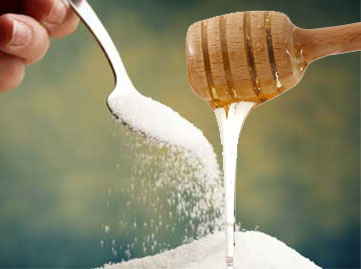
Honey vs Sugar
Last night when we were stretching down after a running training session, the discussion turned to honey and sugar and whether honey was ok, where sugar wasn’t. On the one hand, honey’s sugar, right? So if it’s all sugar, and it’s all pretty much empty calories, it’s all treated the same by your body.
Then on the other hand, there’s also the thought that honey is just “better” for you, so you can use liberally. Most of us sat somewhere in the middle of this spectrum
Here’s a closer look at honey and sugar.
One of the concerns with sugar is that it infiltrates much of what we eat. Even the humble baked bean, or tinned tomatoes will have sugar added to them in many cases. You can find brands that don’t have added sugar, but you need to look closely at the ingredients label. Sugar adds flavour, acts as a preservative, and helps in the browning process, making foods look more appetising.
Sugar is implicated in our obesity epidemic-or is it?
One problem with sugar being added to foods is that it is empty calories. You’ll often read “there’s no nutritional value in sugar” which is actually not true. Anything that yields calories has nutritional value, and sugar provides 4 kilocalories of energy per gram. It’s a carbohydrate, which is a macronutrient. Unfortunately, that’s about where it’s nutritional value ends – if you’re looking for vitamins, minerals, antioxidants, fibre, forget about sugar as a source.
Traditional thinking amongst nutritionist and dieticians about sugar goes something like this: “With sugar, you get lots of energy (aka calories), without feeling any “fuller”, so you tend to take in a larger number of calories for the same feeling of satiety, and no benefits of the micronutrients. Sugar is therefore one of the culprits in our obesity epidemic, with all its associated disease risks”.
A 2011 research project questioned that traditional thinking, and created quite a stir. The study The Australian Paradox: A Substantial Decline in Sugars Intake over the Same Timeframe that Overweight and Obesity Have Increased was conducted by Alan W. Barclay and Jennie Brand-Miller There’s been terse debate surrounding some of the figures used as supporting evidence in this study. In 2012 independent researchers were commissioned to conduct further research and found the same thing as the original research…
that Australians’ per capita consumption of sugars has declined, whilst our obesity levels have increased.
You can read more here and here
Simple and Complex Carbohydrates
Simple sugars occur naturally in some foods. They are called “simple” due to their molecular structure. Monosaccharides are the simplest form of sugar. They are one-unit sugars. They include glucose, fructose and galactose.
Disaccharides are also classified as simple sugars, and are formed when two Monosaccharides combine. They include
Lactose: glucose and galactose
Sucrose: glucose and fructose
Maltose: glucose and glucose
With regard to your health, the real difference is where the sugar comes from. All sugars become simple sugars eventually in the body. Sugars consumed as complex carbohydrates (whole grains, legumes etc) and simple sugars found in fruits and vegetables, are accompanied by other nutrients-vitamins, minerals and other anti-oxidants, and often fibre. The micro nutrients are extremely important for good functioning of your body. Also, sugars consumed with fibre, whole grains and fats will be absorbed into the blood stream more slowly than simple sugars consumed with nothing else.
For example, fructose can be found in lollies and softdrinks – which lack health promoting nutrients, but fructose is also found in fruit.
Even though both foods contain fructose, fruit is the healthier choice – it’s not made up only of simple carbs – it contains fibre, vitamins and antioxidants. The fiber in fruit helps slow the digestion of carbs, which is why your blood sugar doesn’t spike as much after eating fiber-filled fruit like it does when you down a spoonful of sugar (or honey for that matter).
Vegetables and grains also contain some simple sugars in addition to their starches, mostly in the form of sucrose, but they give you heaps of vitamins, minerals and antioxidants too.
What is a sugar, and how do you track it down on food labels?
Sugar comes in many different forms. A clue to hidden sugars on food labels is the suffix ‘ose” such as Sucrose, Maltose, Dextrose, Fructose, Glucose, Galactose, Lactose, High fructose corn syrup, Glucose solids
Other ingredients which are sugars include Cane juice, Dehydrated cane juice, Cane juice solids, Cane juice crystals, Dextrin, Maltodextrin, Dextran, Barley malt, Beet sugar, Corn syrup, Corn syrup solids, Caramel, Buttered syrup, Carob syrup, Brown sugar, Date sugar, Malt syrup, Diatase, Diatastic malt, Fruit juice, Fruit juice concentrate, Dehydrated fruit juice, Fruit juice crystals, Golden syrup, Turbinado, Sorghum syrup, Refiner’s syrup, Ethyl maltol, Maple syrup, Yellow sugar
Sugars in processed foods which are naturally occurring in some of the ingredients are going to be better for you than added sugars, but there’s no way of telling from the food label how much sugar is added sugar, and how much is naturally occurring in the food.
Let’s use the nutritional panel for Weetbix Apricot Bites as an example. (source from http://www.sanitarium.com.au/products/breakfast/weet-bix/apricot-bites )
Weetix Apricot Bites –
| Carbohydrate (g) | 30.6 | 68 |
| – Sugars (g) | 9.6 | 21.4 |
| Dietary Fibre (g) | 4.1 | 9 |
There are 68 gms of carbohydrate in total per 100gms of Weetbox Apricot Bite
- of which 21.4 gms are simple sugars (added or natural) – the ones that are one or two molecules and quickly pass into the bloodstream. From the panel, there’s no way of telling which are added and which are naturally occuring
- and 9gms are dietary fibre,
- leaving 29.6gms of complex carbohydrates per 100gms
Looking at the list of ingredients, will give you some clue as to how much of the sugar is added sugar, and how much naturally occurring in the food. But, you have to hunt around a bit. Ingredients are listed in order of volume (not calories they yieldd). So in Weetbox Apricot Bites, wholegrain cereals are the main ingredients, making up 69% of the Weetbix by weight. The next highest ingredient is raw sugar, but you’ll notice that there is more sugar further down the list, as highlighted.
Wholegrain cereals (69%) [wheat (63%), oats (6%)], raw sugar, concentrated apricot puree (4.5%), humectant (glycerol), invert sugar, sugar, honey (1%), minerals (phosphate of calcium, iron), salt, barley malt extract, wheat fibre, flavours, gelling agent (pectin), acidity regulator (citric acid), colour (paprika), vitamins (niacin, thiamin, riboflavin, folate).
Let’s take a different scenario. Let’s pretend that cereals make up only 30% of the food, and other than that the ingredients list is the same as that above. Raw sugar might be say 25% of the total weight, invert sugar 8%, sugar 3% , honey 1% and barley malt extract 0.5%. That adds up to a total of 37.5% of the weight of the food coming from added sugars, making the total volume of added sugars the highest volume by weight. There’s actually no way of knowing, looking at a list of ingredients, what the total volume of all added sugars is. Interesting…and frustrating!
But is honey any better?
Make no mistake, honey is a sugar, however some types of honey are not absorbed into the blood stream quite as quickly as other sugars, and they also have some antioxidant qualities.
The Glycemic Index (GI) is a measure (on a scale of 0 to 100) of the extent to which carbohydrates raise blood sugar levels after eating. High GI foods are digested and absorbed quickly and lead to large fluctuations in blood sugar levels, which has implications for insulin production, sensitivity and pancreatic exhaustion (basically, we don’t want big fluctuations in our blood sugar levels). You can read more about the GI here
Here’s an extract from the GI (sourced from http://www.glycemicindex.com/index.php) which shows differing GIs for honey and sugar. The differences in the GI in sugar are due the different sources of the sugar. You can see they differ quite a lot. You can also see from the tables if you’re selective in the type of honey you choose, you can find some which are considerably lower on the GI than sugar is. Low GI is considered to be 55 or less, medium 56-69, and high 70 and above.
| Sugar (Sucrose), 50 g portion | 58 | 10 | 10 | 6 |
| Sugar (Sucrose), 50 g portion | 60 | 10 | 10 | 6 |
| Sugar (Sucrose), 25 g portion | 60 | 10 | 10 | 6 |
| Sugar (Sucrose), 50 g portion | 65 | 10 | 10 | 7 |
| Sugar (Sucrose), 100 g portion | 65 | 10 | 10 | 7 |
| Sugar (Sucrose), 50 g portion | 84 | 10 | 10 | 8 |
| Honey, Yellow box (46% fructose) | 35 | 25 | 18 | 6 |
| Honey, Stringy Bark (52% fructose) | 44 | 25 | 21 | 9 |
| Honey, Red Gum (35% fructose) | 46 | 25 | 18 | 8 |
| Honey, Iron Bark (34% fructose) | 48 | 25 | 15 | 7 |
| Capilano Premium Honey, blend of eucalypt & floral honeys | 51 | 25 | 21 | 11 |
| Honey, Yapunya (42 % fructose) | 52 | 25 | 17 | 9 |
| Leabrook Farms Yellow Box honey | 60 | 25 | 21 | 13 |
| Honey, Commercial Blend (38% fructose), WA blend | 62 | 25 | 18 | 11 |
| Honey, Salvation Jane (32% fructose) | 64 | 25 | 15 | 10 |
| Clover honey, ratio of fructose: glucose, 1.09 | 69 | 25 | 21 | 15 |
| Honey, Commercial Blend (28% fructose), NSW blend | 72 | 25 | 13 | 9 |
| Buckwheat honey, ratio of fructose:glucose, 1.12 | 73 | 25 | 21 | 16 |
| Cotton honey, ratio of fructose:glucose, 1.03 | 74 | 25 | 22 | 16 |
| Honey, type not specified | 74 | 25 | 21 | 16 |
| Tupelo honey, ratio of fructose:glucose, 1.54 | 74 | 25 | 21 | 16 |
| Honey, type not specified | 87 | 25 | 21 | 18 |
Some other facts about honey
- Approximately 82% sugar, by weight.
- Contains only trace amounts of vitamins and minerals.
- Honey contains some antioxidants –the less refined the honey, the greater the antioxidant levels (as a general rule). Also, darker varieties tend to be higher in antioxidants
- Its relative glucose and fructose content can vary quite a lot
- The composition of honey depends on the environment that the bees collect the pollen from. antioxidant levels greatly
There have been quite a few studies done on honey. Some of the more interesting results I found were:
- Honey raised blood sugar less than dextrose (glucose) and sucrose (glucose and fructose). It still did raise blood sugar, just not as much.
- Honey reduced C-Reactive Protein (CRP) – a marker of inflammation.
- Honey lowered LDL cholesterol, blood triglycerides and raised HDL cholesterol. (which is a good thing)
- Honey also lowered Homocysteine, another blood marker associated with disease such as heart disease and Alzheimer’s
The Verdict?
On balance, I’d say yes, but don’t kid yourself that you’re not eating sugar if you’re eating honey. Just like sugar, it should be used sparingly. If you’re healthy, active and are not overweight or obese, then having some honey probably won’t hurt you, and it’s at least better than refined sugar. Good for use in some occasional healthy(ish) home made treats.


